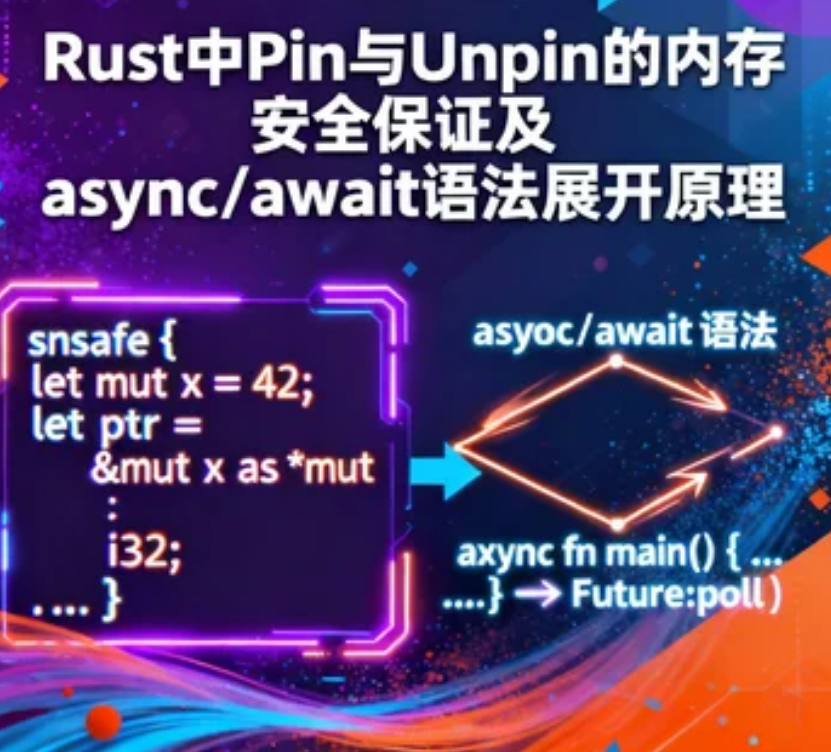文章目录

一、引言
Rust 以其强大的内存安全性和高效的性能在系统编程领域崭露头角。异步编程在现代软件开发中变得越来越重要,Rust 提供了 async/await 这样的语法糖来简化异步代码的编写。而 Pin 和 Unpin 则是保障异步编程中内存安全的关键概念。理解它们对于编写正确、高效的 Rust 异步程序至关重要。
二、Pin 与 Unpin 概述
(一)Pin 的定义与作用
Pin 是 Rust 标准库中的一个类型,它的主要作用是将一个对象固定在内存中的某个位置,防止其被移动。在 Rust 中,许多类型都实现了 Drop 特征,当对象离开作用域时,Drop 特征的 drop 方法会被调用。然而,在一些情况下,对象的移动可能会导致未定义行为,例如自引用结构体。Pin 可以确保这类对象在生命周期内不会被意外移动,从而保证了内存安全。
(二)Unpin 的定义与作用
Unpin 是一个标记特征(marker trait),它的存在表示一个类型可以被安全地移动。大多数 Rust 类型默认都实现了 Unpin 特征。如果一个类型实现了 Unpin,那么它可以自由地在内存中移动,就像普通的 Rust 类型一样。
(三)Pin 和 Unpin 的关系
Pin 和 Unpin 是互补的概念。如果一个类型没有实现 Unpin 特征,那么它可以被 Pin 固定在内存中;反之,如果一个类型实现了 Unpin 特征,那么即使使用 Pin 包裹它,也不会产生实际的限制效果,因为它本质上是可以安全移动的。
以下是一个简单的示例代码,展示了如何使用 Pin:
use std::pin::Pin;
use std::marker::PhantomPinned;
struct Unmovable {
data: String,
_pin: PhantomPinned,
}
impl Unmovable {
fn new(data: String) -> Pin<Box<Self>> {
let res = Unmovable {
data,
_pin: PhantomPinned,
};
Box::pin(res)
}
}
fn main() {
let pinned = Unmovable::new(String::from("Hello"));
// 尝试移动 pinned 会导致编译错误
// let moved = pinned;
}
在上述代码中,Unmovable 结构体包含了一个 PhantomPinned 字段,这使得它没有实现 Unpin 特征。通过 Box::pin 函数,我们将 Unmovable 实例固定在了堆内存中,无法对其进行移动操作。
三、Pin 的内存安全保证机制
(一)防止自引用结构体的数据竞争
自引用结构体是指结构体中的某个字段引用了结构体自身的其他字段。在没有 Pin 的情况下,移动自引用结构体可能会导致引用失效,从而引发未定义行为。Pin 可以通过固定结构体在内存中的位置,确保自引用关系始终保持有效。
以下是一个自引用结构体的示例:
use std::pin::Pin;
use std::marker::PhantomPinned;
struct SelfRef {
data: String,
self_ref: *const String,
_pin: PhantomPinned,
}
impl SelfRef {
fn new(data: String) -> Pin<Box<Self>> {
let mut res = Box::pin(Self {
data,
self_ref: std::ptr::null(),
_pin: PhantomPinned,
});
let raw_self_ref = &res.data as *const String;
unsafe {
let mut_ref = Pin::as_mut(&mut res);
Pin::get_unchecked_mut(mut_ref).self_ref = raw_self_ref;
}
res
}
}
在这个示例中,SelfRef 结构体包含了一个自引用字段 self_ref。通过 Pin 固定结构体,我们保证了 self_ref 始终指向正确的 data 字段,避免了数据竞争和未定义行为。
(二)确保异步任务中的状态一致性
在异步编程中,异步任务的状态通常存储在结构体中。如果这些结构体被意外移动,可能会导致状态不一致的问题。Pin 可以确保异步任务的状态结构体在生命周期内保持固定,从而保证了异步任务的正确执行。
假设我们有一个简单的异步任务,用于读取文件并处理数据:
use std::fs::File;
use std::io::{self, BufRead};
use std::pin::Pin;
use std::task::{Context, Poll};
use futures::stream::Stream;
struct FileProcessor {
file: Option<File>,
buffer: String,
_pin: PhantomPinned,
}
impl FileProcessor {
fn new(file_path: &str) -> io::Result<Pin<Box<Self>>> {
let file = File::open(file_path)?;
Ok(Box::pin(Self {
file: Some(file),
buffer: String::new(),
_pin: PhantomPinned,
}))
}
}
impl Stream for FileProcessor {
type Item = io::Result<String>;
fn poll_next(mut self: Pin<&mut Self>, cx: &mut Context<'_>) -> Poll<Option<Self::Item>> {
let this = unsafe { self.as_mut().get_unchecked_mut() };
if this.buffer.is_empty() {
let mut line = String::new();
if let Some(ref mut file) = this.file {
match file.read_line(&mut line) {
Ok(0) => return Poll::Ready(None),
Ok(_) => this.buffer = line,
Err(e) => return Poll::Ready(Some(Err(e))),
}
}
}
let result = Ok(this.buffer.clone());
this.buffer.clear();
Poll::Ready(Some(result))
}
}
在这个示例中,FileProcessor 结构体实现了 Stream 特征,用于处理文件的每一行数据。通过 Pin 固定 FileProcessor 实例,我们确保了在异步任务执行过程中,文件句柄和其他状态字段的位置不会发生变化,从而保证了状态的一致性。
四、async/await 语法糖展开原理
(一)async 块的本质
async 块实际上是一个状态机。当编译器遇到 async 块时,它会将其中的代码转换为一个实现了 Future 特征的状态机。每个 await 点都会对应状态机的一个状态。
以下是一个简单的 async 块示例:
async fn add_numbers(a: i32, b: i32) -> i32 {
let result = a + b;
result
}
编译器会将上述 async 块转换为类似如下的状态机代码(简化示意):
struct AddNumbersFuture {
state: usize,
a: i32,
b: i32,
result: Option<i32>,
}
impl Future for AddNumbersFuture {
type Output = i32;
fn poll(mut self: Pin<&mut Self>, cx: &mut Context<'_>) -> Poll<Self::Output> {
match self.state {
0 => {
self.result = Some(self.a + self.b);
self.state = 1;
Poll::Ready(self.result.take().unwrap())
}
_ => panic!("Invalid state"),
}
}
}
在这个状态机中,state 字段表示当前的状态,a 和 b 是输入参数,result 用于存储计算结果。
(二)await 表达式的展开
await 表达式实际上是调用了 Future 的 poll 方法。当执行到 await 表达式时,当前的任务会暂停,直到 Future 完成。一旦 Future 完成,任务会恢复执行,并获取 Future 的结果。
假设我们有一个异步函数,它调用了另一个返回 Future 的异步函数:
async fn outer_async_function() -> i32 {
let future_result = inner_async_function().await;
future_result + 1
}
async fn inner_async_function() -> i32 {
42
}
编译器会将上述代码展开为类似如下的逻辑:
fn outer_async_function(cx: &mut Context<'_>) -> Poll<i32> {
struct OuterFuture {
state: usize,
inner_future: Option<Pin<Box<dyn Future<Output = i32>>>>,
result: Option<i32>,
}
impl Future for OuterFuture {
type Output = i32;
fn poll(mut self: Pin<&mut Self>, cx: &mut Context<'_>) -> Poll<Self::Output> {
loop {
match self.state {
0 => {
let inner_future = inner_async_function();
self.inner_future = Some(Box::pin(inner_future));
self.state = 1;
}
1 => {
let inner_future = self.inner_future.as_mut().unwrap();
match inner_future.poll(cx) {
Poll::Ready(result) => {
self.result = Some(result + 1);
self.state = 2;
}
Poll::Pending => return Poll::Pending,
}
}
2 => return Poll::Ready(self.result.take().unwrap()),
_ => panic!("Invalid state"),
}
}
}
}
let outer_future = OuterFuture {
state: 0,
inner_future: None,
result: None,
};
outer_future.poll(cx)
}
在这个展开后的代码中,我们可以看到 outer_async_function 被转换为了一个状态机,并且在遇到 await 时,会正确地调用 inner_async_function 返回的 Future 的 poll 方法。
(三)async/await 与 Pin 的关系
在 async/await 语法糖的背后,Pin 起到了至关重要的作用。由于异步任务的状态机可能会包含自引用或其他不能被移动的结构,因此需要使用 Pin 来固定这些状态机的位置,确保内存安全。当一个 async 函数被调用时,它返回的 Future 通常会被 Pin 固定,以保证在异步任务的执行过程中,状态不会被意外破坏。
以下是一个结合 Pin 和 async/await 的示例:
use std::pin::Pin;
use std::task::{Context, Poll};
use futures::future::{ready, Future};
async fn pinned_async_function() -> i32 {
let pinned_data = Box::pin(42);
let result = *pinned_data;
result
}
struct PinnedAsyncFuture {
pinned_data: Pin<Box<i32>>,
}
impl Future for PinnedAsyncFuture {
type Output = i32;
fn poll(mut self: Pin<&mut Self>, _cx: &mut Context<'_>) -> Poll<Self::Output> {
Poll::Ready(*self.pinned_data)
}
}
fn pinned_async_function_as_future() -> PinnedAsyncFuture {
PinnedAsyncFuture {
pinned_data: Box::pin(42),
}
}
在这个示例中,pinned_async_function 是一个异步函数,它使用了 Pin 固定的数据。pinned_async_function_as_future 函数将异步函数转换为了一个 Future,并且在 Future 的实现中,也正确地处理了 Pin 相关的逻辑。
五、Pin 和 Unpin 的应用场景对比
| 特征 | 应用场景 | 示例 |
|---|---|---|
| Pin | 1. 自引用结构体,防止移动导致引用失效。 2. 异步任务的状态机,确保状态一致性。 | 自引用结构体 SelfRef 的示例;异步文件处理的 FileProcessor 示例。 |
| Unpin | 大多数普通的 Rust 类型,默认可安全移动,适用于不需要特殊内存管理的场景。 | 普通的结构体 struct NormalStruct { data: i32 },可以直接进行移动操作。 |
六、总结
本文详细介绍了 Rust 中 Pin 和 Unpin 的内存安全保证机制以及 async/await 语法糖的展开原理。Pin 作为一种强大的工具,能够有效地防止自引用结构体的数据竞争和异步任务中的状态不一致问题。Unpin 则提供了一种简单的方式来标识可以安全移动的类型。async/await 语法糖通过将异步代码转换为状态机,并结合 Pin 的使用,使得异步编程更加简洁和直观。理解这些概念对于编写高质量、安全的 Rust 异步程序具有重要的意义。
在实际开发中,合理运用 Pin 和 Unpin 以及正确理解 async/await 的底层原理,可以帮助开发者更好地管理内存和处理异步任务,充分发挥 Rust 在系统编程和异步领域的优势。





















 702
702

 被折叠的 条评论
为什么被折叠?
被折叠的 条评论
为什么被折叠?








